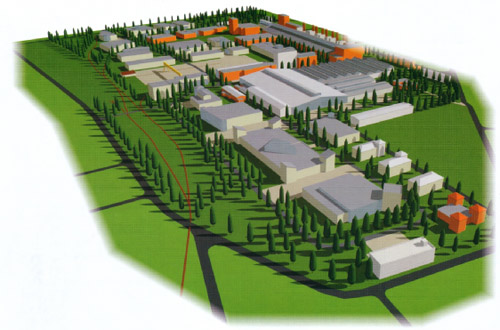Ethiopia is increasingly being recognized as a major investment destination because of its fast-paced economic progress, its unique location, cheap labor and a huge market potential. The industrial park strategy of the country is expected to give a considerable boost of the development of the economy and transform Ethiopia into a light manufacturing hub. This article was originally published in the 8th issue (October 2017) of The Ethiopian Messenger, the quarterly magazine of the Embassy of Ethiopia in Brussels.

Ethiopia is increasingly being recognized as a major investment destination because of its fast-paced economic progress, its unique location, for the booming business opportunities it provides, the cheap provision of labor and energy, and for its attractive investment incentives. The country is located at the crossroads between Africa, the Middle East and Asia. It has a stable political, economic and regulatory environment. Thanks to its large population, Ethiopia is also potentially one of the largest domestic markets in Africa. By virtue of its membership of the Common Market for Eastern and Southern Africa (COMESA), embracing 19 countries with a population of over 400 million, Ethiopia also enjoys preferential market access to these countries, and it also qualifies for preferential access to European Union market under the EU’s Everything-But-Arms (EBA) initiative and to USA markets under the African Growth and Opportunities Act (AGOA). Moreover, competitive investment incentive packages including tax holidays are offered to investors.
Ethiopia envisions to become a middle-income country by 2025. The Second Growth and Transformation Plan (GTP II), a policy framework which outlines the development and transformation of Ethiopia’s economy between 2015 and 2020, is oriented at this end. Besides the construction of infrastructure, one of the core strategies of the GTP II is the establishment of industrial parks. The manufacturing sector is expected to grow by 25% per year for the next decade and could secure 30 billion USD from the textiles sector by 2030. The goal is that the manufacturing sector would contribute 20 percent of Ethiopia’s GDP and 50 percent of the export volume by 2025.
The development and construction of industrial parks started in 2014 when the Ethiopian Industrial Parks Development Corporation (IPDC) was established. It gained momentum in 2015 with the Industrial Parks proclamation 886/2015. In less than three years, several industrial parks were built, inaugurated and started operations. Bole Lemi I and Hawassa industrial parks were inaugurated in 2016. More recently, on 8 and 9 July 2017, Ethiopia inaugurated two additional parks in Kombolcha and Mekele. Together, these two new sites are expected to create around 40,000 new jobs. About 10 more parks are under construction and are expected to be operational within the next months, and the total number of industrial parks should reach 15 by June 2018. In addition, industrial parks developed by private investors, such as the Huajian Group which developed a shoe cluster industrial park, are being built throughout the country.
Fast pace of industrial Park inaugurations
Hawassa Industrial Park was inaugurated in 2016, in the presence of the Ethiopian Prime Minister Hailemariam Desalegn and 18 companies from 11 countries. It is the biggest industrial park of its kind in Africa. It will host textile and apparel industries on a total of 140 hectares once fully operational. 10,000 employees are already working on the site today, but this number could soon reach 60,000 workers. The park is fitted with a Zero Liquid Discharge technology facility with a daily processing capacity of 11 million liters of effluent, a system which is also expected to be replicated to other industrial parks across the country, which could accelerate Ethiopia’s pace in developing a green economy. The industries hosted in the park started to export products in March 2017.
The Mekele and Kombolcha industrial parks, inaugurated in the summer of 2017, were both built by China Civil Engineering Construction Corporation (CCECC) at a cost of 100 million U.S. dollars and 90 million dollars respectively. They also host textile and apparel industries. The Kombolcha industrial park will house 13 factory sheds. It is expected to create a total of 10,000 jobs. The Mekele Industrial Park houses 15 factory sheds, about half of which were handed over to high-profile textile manufacturers. The Tigray Small and Medium Manufacturing Industries Development Agency has recruited over 10,000 job seekers from the region, but the total number of jobs provided in the park is expected to reach 20,000 once the facility is fully operational.
Adama and Dire Dawa industrial parks are expected to be inaugurated later this year. Kilinto pharmaceutical and Bole Lemi II agro-processing industrial parks will be commissioned in January 2018. A few months later, Bahir Dar and Jimma industrial parks will become operational, and in June 2017, Debre Birhan and Arerti industrial parks are expected to start operations.
Positive response from the Investors
The investor’s response has been very positive. H&M is already a stakeholder in the Mekele and Bole Lemi industrial parks, while PVH, which owns brands such as Calvin Klein and Tommy Hilfiger, decided to build a factory in the Hawassa Industrial Park. Carvico S.p.A from Italy, Trybus from USA and Pungkook Corporation from Korea built their factories in Kombolcha and Mekele industrial parks. Yang Nang, general manager of the Wuxi Group, said they chose Ethiopia for their next factory because it has a stable political situation and a peaceful society, because it has 100 million people and is the second biggest country in Africa, which is important for textile business, and finally because production and labour costs is very low.
European companies are also attracted by the newly opened park. Ontex, a Belgian company producing diapers successfully opened a 11,000 m2 factory in the Hawassa industrial park in July 2017 to supply the well-known Canbebe diaper brand to the local market. The new 11,000 m2 factory site is equipped with state-of-the-art technology.
All in all, the country’s industrial policy and its goal to become a manufacturing hub in the region will help the country to transform and expand its economy. By attracting FDIs, the industrial parks have already provided thousands of direct and indirect jobs for the local population, supporting the economic dynamism of the regions as a whole were the different industrial parks are located. The new industrial parks have also started to attract sophisticated technology and introduce it to the local manufacturing sector. This technology transfer and experience gains will allow an acceleration of a homegrown industrial activity and allow the transformation of raw products from Ethiopia, which will allow the Ethiopian economy to produce more value.
The new industrial facilities will also help to absorb the huge workforce of Ethiopia. Every year, about 600,000 young graduates enter the job market in Ethiopia, and the development of labor-intensive sectors like textile and light manufacturing will provide them with many professional opportunities. Universities, colleges and technical and vocational schools are expected to adapt to this development and train more competent workforce, generate amply trained human power and feed the growing demand of investors for skilled human power.




